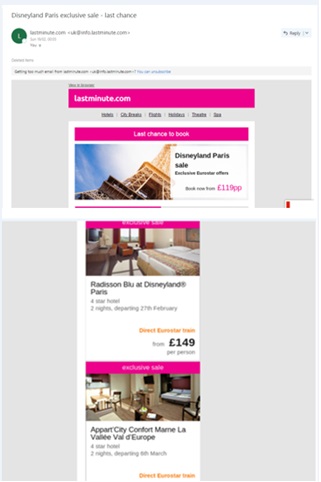Daily, I receive multiple emails regarding the travel industry, there is only a small percentage of the time that I open the email and assess the deals offered. But what was it about those specific emails that made me open them and lead me to explore further?
Firstly, customers will tend to only open the email if it’s from a brand they recognise (Ryan, 2014). So, the first step is to make it clear who your email is from and your brand is clearly displayed before needing to open the email, otherwise it will go straight into the deleted bin!
Studies show a 500% incline between 2011 and 2014 in the amount of emails opened from a smartphone, (Jordon, 2015). With the rise of emails being opened on mobile devices, it is vital for email campaigns to have an eye catching subject line and headline to draw the attention and therefore lead to opening. With mobile devices having a much smaller screen than computers and laptops, the opening line must be short and easy to read on a mobile device. Ellis-Chadwick & Doherty, (2012) explains the subject line in the email is the first point of contact and needs to encourage the recipient to open. Without the need, urgency or value shown at the first glance, the recipient will not be interested.
Looking at travel and leisure company emails and focusing on their subject line and headlines, there were some emails more attractive to me than others.
I personally was drawn to the Expedia.co.uk with the subject line ‘It’s your lucky day! We’ve chosen you to enjoy this…’ and ‘Confirmed! You’ve scored awesome discounted flights…’This is because I felt it had some enthusiasm and even though it didn’t include my name I felt it was personalised and was directed at only me. It’s important to use email marketing to build customer relations, and to start this process by using a personalized subject line (Mohammadi et al.,2013). Teo, (2005) explained that if you provide a personalised service via email you can provide customers with a feeling of uniqueness. Travel companies have an advantage as they can use previous data of customer’s past holiday bookings to then entice them to purchase another. They can time their emails in relation to popular travel seasons, or popular holiday booking seasons to make sure they target customers at the right time. To see more ideas that travel companies can use to create successful email marketing can be found at http://www.adestra.com/7-email-marketing-tips-travel-companies-can-implement-today/ .
The next important factor to contribute to the success of an email campaign would be the content of the message, which must be aligned to the subject line and headline shown and offer immediate gratification when opening (Ratcliff, 2014). I received the email below, after previewing the intriguing subject line, I decided to open it. However, I was disappointed as I thought it would give be examples of what these ‘awesome low-fare flight deals’ are, maybe providing me with different countries that this deal applies to. However, as you can see below there isn’t much more details provided, I then must click on the pictures and links to find out any information about these deals I have been invited to look at.
However, I much preferred the content of an email from lastminute.com for Disneyland deals, it provided me with exactly what I thought it would from the subject line and gave me a few options with hyperlinks and images attached to view more. It also included a matter of urgency – ‘last chance to book’ which encourages me to keep looking and make sure I did there and then.
This email is also a suitable length, of around 3 pages with all relevant information throughout. Studies show the length of emails ranged between 1 – 5 pages and the average length was 2.4 pages, (Ellis-Chadwick & Doherty, 2012).
But how frequent are the travel industry sending out email campaigns? From the research by Ratcliff, (2014), It seems like there definitely can be ‘too many emails’ being sent in a certain period. The travel industry is selling luxury products that are not consumers every day purchase. Too many emails promoting holiday deals which usually require more thought when purchasing can become extremely annoying therefore the unsubscribe button could look increasingly tempting.
The most important factors for travel companies to focus on within their email campaigns would be a catchy subject line as this is the first point of contact (Ellis-Chadwick & Doherty, 2012). To also increase the success of this first step would be to include personalisation. Personalisation instantly makes your email engaging and more inviting (Barsby, 2016). But Finally, to have good and relevant content to what your subject line was promoting without this link and continuity this will just confuse and frustrate customers and they will not be encouraged to look any further.
References
Barsby, A. (2016) Xanthos Blog. Available at: https://www.e-xanthos.co.uk/blog/9-benefits-personalisation-digital-marketing/ (Accessed: 22 February 2017).
Ellis-Chadwick, F., & Doherty, N. F. (2012). Web advertising: The role of e-mail marketing. Journal of Business Research, 65(6), 843-848.
Jordan, J. (2015) 53% of Emails opened on mobile, outlook opens decrease. Available at: https://litmus.com/blog/53-of-emails-opened-on-mobile-outlook-opens-decrease-33 (Accessed: 21 February 2017).
Mohammadi, M., Malekian, K., Nosrati, M., & Karimi, R. (2013). Email Marketing as a Popular Type of Small Business Advertisement: A Short Review. Australian Journal of Basic and Applied Sciences, 7(4), 786-790.this
Ratcliff, C. (2014) How the travel industry uses email marketing. Available at: https://econsultancy.com/blog/65007-how-the-travel-industry-uses-email-marketing (Accessed: 22 February 2017).
Ryan, D (2014) Understanding Digital marketing: Marketing strategies for engaging the digital generation. 3rd ed. London: Kogan Page Limited
Teo, T.S.H. (2005) ‘Usage and effectiveness of online marketing tools among business-to-consumer (B2C) firms in Singapore’, International Journal of Information Management, 25(3), pp. 203–213. doi: 10.1016/j.ijinfomgt.2004.12.007.



